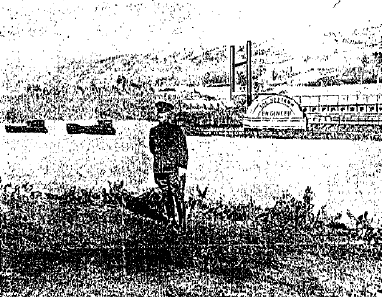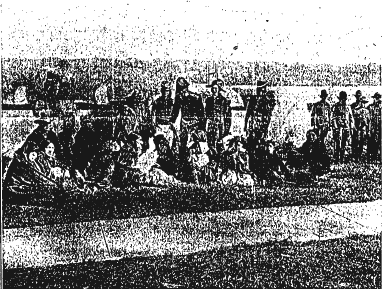WHY FORT ATKINSON WAS ESTABLISHED
By Albert Watkins
In my address at the centennial
celebration of the event, on October 11, I undertook to
answer that question comprehensively - to show that the post
was established on account of international complications
which had an intimate relation to the titanic struggle of
England with France and Spain during more than two hundred
years the American phase of which began to culminate in the
conquest by England of the vast French domain called Canada
in 1762; that the other English colonies conquered
independence and then got rid of France and Spain by
acquiring from France what is called the Louisiana Purchase,
in 1803, and Florida from Spain in 1819-21. Rightfully,
Louisiana belonged to Spain, for the Great Napoleon had
acquired it only in trust in 1800.
Thus the United States finished what
England had left undone - did just as England would have
done if she had not lost her colonies by the revolution.
About the time that Spain lost Florida, Mexico, by achieving
independence, gained all the rest of her territory in North
America.
Even after the war of 1812, between
England and the United States, British fur traders continued
to trespass upon our territory, and her powerful
organizations, the Mackinaw Company, the Northwest Company
of Montreal, and the Hudson Bay Company, controlled the
business along our entire northern border (which then
extended not farther west than the Rocky Mountains), and
they skillfully induced the Indians to aid them in the
aggression. Immediately after the peace of 1815, Monroe,
then secretary of war, recommended that a military post be
established at the mouth of the Yellowstone River. In 1816
Monroe was elected president, and in 1817 John C. Calhoun,
his secretary of war, undertook the great enterprise of
establishing a chain of posts along the entire northern
border, to guard against the hostility of the Indians who,
he declared, were "open to the influence of a foreign
power." An act of Congress passed April 29, 1816, prohibited
persons not citizens from going into territory held by
Indians within the United States without passports, and the
issue of licenses to such persons to trade with Indians
within the United States. The posts were needed to enforce
this act.
In his annual message to Congress on
November 16, 1818, President Monroe explained the status as
follows:
With a view to the security of our inland
frontiers, it has been thought expedient to establish strong
posts at the mouth of the Yellow Stone River and at the
Mandan village on the Missouri and at the mouth of St.
Peters on the Mississippi, at no great distance from our
northern boundaries. It can hardly be presumed while such
posts are maintained in the rear of the Indian tribes that
they will venture to attack our peaceable inhabitants. A
strong hope is entertained that this measure will likewise
be productive of much good to the tribes themselves,
especially in promoting the great object of their
civilization.
Instead, there was intermittent warfare
between whites and Indians "in all the wide border" in
question up to the beginning of the sixties, and from that
time almost continuous war, with many massacres, until by
about 1879 all the tribes had been forced onto circumscribed
reservations, where their remnants still remain.
In his annual message of December 7, 1819,
the president reported that
The troops intended to occupy a station at
the mouth of the St. Peters, on the Mississippi, have
established themselves there and those who were ordered to
the mouth of the Yellow Stone, on the Missouri, have
ascended that river to the Council Bluff, where they will
remain until the next spring, when they will proceed to the
place of their destination.
Distance continued to enchant the
president's expectations touching the Indians. "I have the
satisfaction to state," he continues, "that this measure has
been executed in amity with the Indian tribes, and that it
promises to produce, in regard to them, all the advantages
which were contemplated by it." In less than four years -
the spring of 1823 - there was a bloody clash between
American traders and the chronically hostile Blackfeet, and
also with the Arikari.
There had always been jealous opposition
in the East to expansion in the West - against the
acquisition of Louisiana, for example; but in this case it
was most strenuous in the Southwest. The scandals attending
the Yellowstone Expedition, which was sent up the Missouri
in 1819 to establish the proposed posts, so strengthened
this opposition that it was able to force the abandonment of
the principal part of the enterprise and confine it to
maintenance of but one post, at Council Bluff, far below the
two sites at first projected. On December 29, less than a
month after the president's announcement that the original
plan would be carried out the secretary of war, in answer to
an inquisitorial letter from the chairman of the House
committee on military affairs, said that "to
|
guard against the hostility of Indians, who were "open to
the influence of a foreign power," measures had been taken
"to establish strong posts at the Council Bluffs and the
Mandan village on the Missouri . . . " In the meantime the
secretary, and presumably the president also, had discovered
that
The position at the Council Bluff is a
very important one, and the post will consequently be
rendered strong. . . . It is at the point on the Missouri
which approaches the nearest to the post at the mouth of the
St. Peters, with which, in the event of hostilities, it may
cooperate.
Being but "180 miles in advance of
settlements on the Missouri and in the center of the most
numerous and powerful Indian population west of the
Mississippi," the secretary believed it "to be the best
position on the Missouri," and aside from other objects,
"ought to be established for that purpose alone." But other
considerations soon developed which superseded these
superior advantages. On the 7th of March, 1827, an order was
issued by the war department for establishing a post near
the mouth of the Little Platte River, and on the eighth of
May, Colonel Henry Leavenworth reported the selection of the
site for the famous fort which has always borne his name. On
the 6th of June a flotilla of three keel boats and four
barges started with the garrison and equipment of Fort
Atkinson on the way to Cantonment Leavenworth.
The principal reasons for thus changing
the location of the post were, that it should be nearer the
Indians, who in great numbers were soon to be removed from
their homes east of the Mississippi River to territory now
included in Kansas and Nebraska, and to the Santa Fe Trail,
whose traffic had lately become important. The report of
Colonel Croghan, inspector general of the army, after an
examination of Fort Atkinson in 1826, that the Indians were
at peace and "nothing is likely to disturb the present
quiet," and the almost fantastic theory of General Jacob
Brown, commander-in-chief of the army, formulated in a
letter to the secretary of war, dated January 11, 1826, that
large bodies of savages could not find a secure retreat in
the open country between the Missouri River and the Rocky
Mountains; that "Without the refuge and protection of
forests they would not venture in the prosecution of
hostilities against us"; and even if they should, "it would
not require a large command of well trained mounted
infantry, with a few pieces of light or flying artillery, to
disperse any force of savages which might be collected to
oppose them and, if it should be necessary, sweep them to
the Rocky Mountains."
Such fatuous misapprehension and the
interruption of the Civil War prepared a proof of the
pudding in sanguinary contrast to the pleasant fancy. As
late as 1841, the secretary of war expressed in his report
his belief that a line of stockaded forts, with log
blockhouses, advanced into the Indian country, "would afford
sufficient protection against an enemy unprovided with
artillery," and his "plan of defense" contemplated no post
at all west of Forts Snelling and Leavenworth. The practical
opening of the Oregon Trail the very next year, which was so
soon to compel construction of a chain of posts along its
line, was evidently, and it seems incomprehensibly,
unforeseen. Lewis and Clark traveled about 3, 670 miles from
the point which became the eastern terminal of the Oregon
trail to Fort Vancouver, opposite the mouth of the
Willamette. The Trail cut-off reduced the distance some
1,700 or 1,800 miles. As the fur fields were extended
southward from the headwaters of the Missouri to the
headwaters of the Platte, traders more and more followed the
valley of the great Nebraska river, the best natural road of
its length in the world, to get to them. Presently emigrants
to Oregon discovered that the rest of the route beyond the
Platte was practicable, though difficult.
At first, then, Fort Snelling, high up on
the Mississippi, and Fort Atkinson and its successor, Fort
Leavenworth, were the western or rather, north western
military outposts. Then, for the reasons above indicated, in
1848 and 1849, the line - Forts Kearny, Laramie, and Hall -
cut into the heart of the country. Until the Oregon question
arose - between the United States and England - American
interest in the northwest had been confined to the Nebraska
country, but it then crossed the Rocky Mountains into the
Oregon country. Accordingly, President Monroe in his last
message to Congress, in 1824, recommended the construction
of a fort on the Columbia River, for the purpose of
protecting and forwarding American interests in that
debatable region. The dispute had become acute by 1841, and
in his annual report for that year the secretary of war
recommended the construction of a chain of posts "from the
Council Bluffs to the mouth of the Columbia, so as to
command the avenues by which the Indians pass from the north
to the south, and at the same time maintain a communication
with the territories which belong to us on the Pacific."
Probably the secretary had consulted Colonel J. J. Abert,
topographical engineer
|



